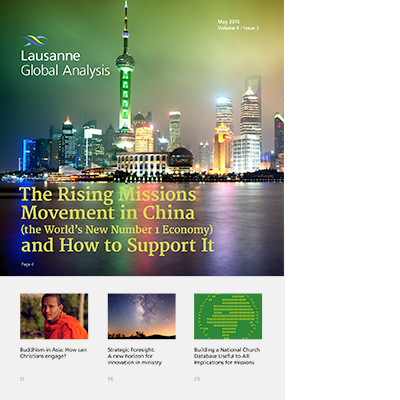Welcome to the May issue of Lausanne Global Analysis.
Whether you are planning to read the full articles or just the executive summaries, we hope that you find this issue stimulating and useful. Our aim is to deliver strategic and credible analysis, information, and insight so that as an influencer you will be better equipped for the task of global mission. It’s our desire that the analysis of current and future trends and developments will help you and your team make better decisions about the stewardship of all that God has entrusted to your care.
In this issue there are two broad themes: mission in East Asia and new approaches to research and planning for mission (timely in view of the Lausanne Researchers’ International Network meeting taking place later this month, 23-28 May, in Kuala Lumpur, Malaysia). Specifically we feature China’s rising missions movement; we continue our series of articles on engagement with other faiths by examining Asian Buddhism; and we consider the benefits both of strategic foresight in ministry and of building national church databases for mission.
‘The church in China has been maturing in its theological and biblical understanding of the role of the church in world missions’, writes David Ro (Director of the J Christy Wilson Center for World Missions at Gordon-Conwell Theological Seminary). Chinese leaders are taking into account lessons from past difficult experiences, focusing on healthy sending bases and sending structures, unity, and a humbler posture. Whether the political environment tightens or not, the Chinese church will continue with its call. On the basis that 20,000 foreign missionaries have been sent to China in the last 200 years, the Mission China 2030 challenge is to see at least 20,000 Chinese missionaries overseas by 2030. China’s example should inspire church leaders anywhere to come together in unity to accomplish a global mission vision for their country. They also need to be prepared for a Chinese church on a mission with a global reach. ‘Through trials and suffering, God has faithfully blessed the church in China so that it may be a blessing to the world’, he concludes.
‘Christian mission among Buddhists in Asia has traditionally been “very hard”, not because of open conflict necessarily, but because of indifference to or misunderstanding of the gospel, or because of the way the gospel has been offered’, writes Hugh Kemp (adjunct lecturer in missiology at St John’s College, Auckland, New Zealand). Buddhism throws up many challenges but there are a number of ways that Christians can approach Buddhists. When a Christian seeks to engage with Buddhists, it is a common experience to feel overwhelmed. The categories are complex, based on fundamental differences in worldview assumptions, but a respectful conversational approach, seeking to listen well so as to clarify meanings, but also being unapologetic about differences, is a good approach. ‘Conversations that may yield fruit for the gospel could concern praxis, doctrine/theology, authority, the Ideal Person, and spiritual power’, he concludes.
‘If we had simply continued doing what we were doing, taking incremental steps to do it a little better each year, we would probably never have set foot on the moon’, writes Derek Seipp (East Asia Operations Manager for Act Beyond). Yet, this is where most of us find ourselves: looking for steady, incremental improvements. The problem with this kind of thinking is that we look back at what we have done in order to see what is possible in the future. Great horizons always push us to look forward beyond ourselves. Once we understand the desired future, we walk back to the present and figure out how to get there. This kind of thinking results in innovative, paradigm-changing ways of impacting our world. Leaders must seek to understand the most likely environments to emerge in the future. One way to do this is by studying the emerging trends, issues, and choices being made to create forecasts about their future environment. ‘The greater these are understood, the clearer the forecast of the future will be’, he concludes.
‘Church statistics were born the same day the Christian church was born, when the apostles decided to count the new believers who were baptized’, write Dwight Martin and Marten Visser (Directors of GlobalRize). There is now a whole industry of such information. However, because of their global scope, currently available lists do not go down to the level needed for strategic decision-making in missions. In addition, not enough insider information has been used to produce them. GlobalRize offers ‘online solutions for the global church’. A primary solution of GlobalRize is Harvest, a highly secure cloud-based database and mapping web-application. Harvest has the potential radically to change the face of mission statistics by making an insider perspective on a national church possible for everyone. It is the authors’ conviction that ‘this contributes to the advancement of God’s kingdom in many ways, most notably in showing all the areas in a country where the gospel has not yet reached’.
Please send any questions and comments about this issue to analysis@lausanne.org. The next issue of Lausanne Global Analysis will be released in July.

